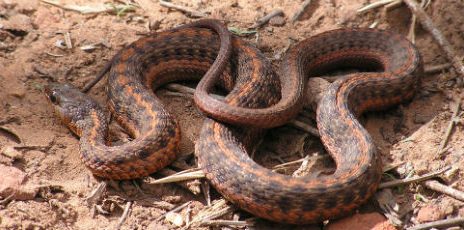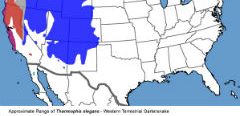External links for Wandering Gartersnake
Wandering Gartersnake
Thamnophis elegans vagrans

Identification
The western terrestrial (wandering) gartersnake is found in a confusing array of striped and non-striped forms, with or without black spots. Most adults are reddish-brown, olive-grey, greenish, or tan in background color, and many have yellow or cream stripes on the 2nd and 3rd scale rows, and a yellow or cream dorsal mid-dorsal (center of the back) stripe. Most individuals have obvious black square-edged small blotches or spots on the back. Some individuals (typically juveniles, but also some adults) lack stripes; individuals in Oak Creek Canyon may have a reddish or orange-tan background color with orange stripes. Juveniles typically have all-black or dark grey heads. Some individuals, especially juveniles, may have obvious paired black neck blotches. Adult female western terrestrial gartersnakes reach about 36 inches in total length (900 mm; Brennan and Holycross 2006).
Similar striped gartersnake species include the black-necked gartersnake and the northern Mexican gartersnake. In addition to range (wandering gartersnakes are typically found at higher elevations than other gartersnake species, e.g. wandering gartersnakes occur around Flagstaff), the species may be differentiated by the position of the side stripes. In northern Mexican gartersnake these stripes are on the 3rd and 4th scale rows. Wandering gartersnakes typically do not have very broad heads as adults (they are also not likely to flatten their heads as a defensive display, as northern Mexican gartersnakes do), nor are their face scales so clearly outlined by black borders as in the other two species.
Non-striped wandering gartersnakes have an obviously shorter face than narrow-headed gartersnakes. Also, the blotches or spots of non-striped wandering gartersnakes blotches tend to resemble regularly spaced square dots, whereas narrow-headed gartersnake blotches are typically more rounded and irregular, may touch each other, and are often most obvious in the anterior part of the body.

Distribution
Ranges widely from the California coast north through most of northern California, Oregon, Washington, Idaho and Montana, into Canada, including Vancouver Island, British Columbia, Alberta and Saskatchewan, and east into the states of Wyoming, Colorado, Utah, Arizona and New Mexico and just barely making it into South Dakota, Nebraska, and Oklahoma. Many isolated populations exist, including those in the San Bernardino Mountains, CA and one in Baja California Norte, Mexico (the San Pedro Martir Gartersnake.). It is found in a wide variety of communities including Great Basin Desertscrub, Plains and Great Basin Grassland, Great Basin Conifer Woodland, Petran Montane Conifer Forest, and Petran Subalpine Conifer Forest. It seems to be most abundant in the vicinity of water such as streams, stock tanks, and lakes but is also found in open forest, meadows, and grasslands far from standing water.
Ecology
This primarily diurnal snake hibernates during the cold months of late fall and winter. It forages on the ground and in the water for a wide variety of prey items including fish, amphibians, small mammals, birds, insects, snails, worms, snakes and leeches.
Mating takes place in spring and a litter of up to 27 young is born in July, August, or September.
(Distribution and Ecology information by Thomas C. Brennan)